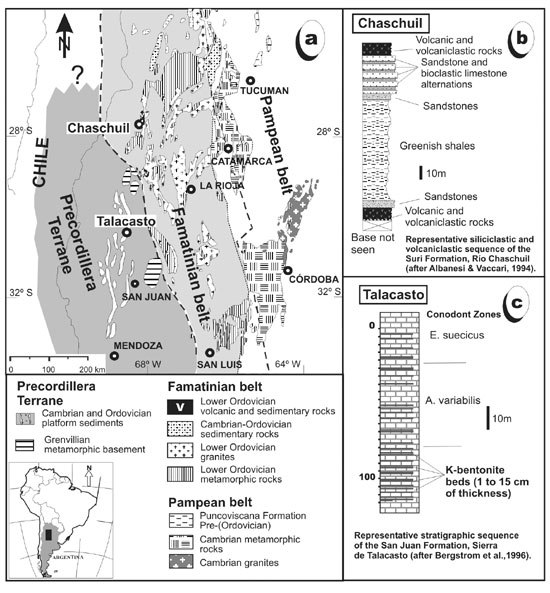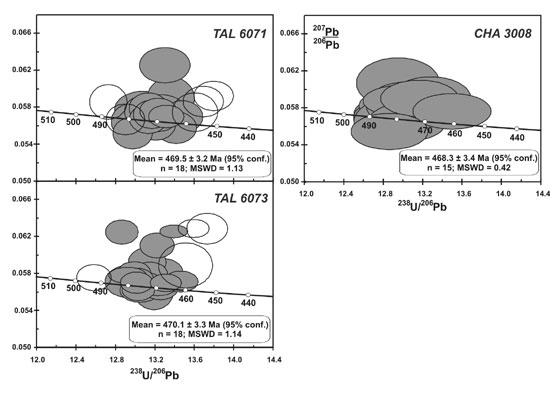
U–Pb shrimp dating of rhyolite volcanism in the Famatinian belt and K–bentonites in the Precordillera
Edgardo G. Baldo1, C. Mark Fanning2, Carlos W. Rapela3, Robert J. Pankhurst4, César Casquet5 and Carmen Galindo5
1 Departamento de Geología, Universidad Nacional de Córdoba, Argentina. E–mail: ebaldo@efn.uncor.edu
2 RSES, The Australian National University, Canberra ACT 0200, Australia.
3 Centro de Investigaciones Geológicas, Universidad Nacional de La Plata, La Plata, Argentina.
4 British Geological Survey, Keyworth, Nottingham, NG12 5GG, UK
5 Departamento de Petrología y Geoquímica, Universidad Complutense, 28040 Madrid, Spain.
Key words: Zircon age. Geochronology. Stratigraphy. Ordovician magmatism. Sierras Pampeanas.
Introduction
The Famatinian magmatic belt (Figure 1a) of the Sierras Pampeanas, Puna and Eastern Cordillera, constitutes the largest Early Palaeozoic igneous province in South America. Most tectonic interpretations (e.g., Rapela et al., 1992; Toselli et al., 1996) suggest emplacement in a continental margin arc preceding Ordovician–Silurian accretion of the Precordillera terrane to the W (e.g., Astini et al., 1995). Famatinian magmatism is dominated by I– and S–type granitic rocks, with U–Pb ages in the range ~470–500 Ma (Pankhurst et al., 2000). Ordovician volcanic and volcaniclastic successions crop out in the NW sector of the Sierra de Famatina and the Puna (Mannheim and Miller, 1996; Saavedra et al., 1998; Rapela et al., 1992, Astini and Dávila, 2002). The volcanic rocks form an essentially bimodal association of basalt and subalkaline rhyolite, with less common intermediate compositions (Mannheim and Miller, 1996). Associated volcaniclastic rocks are interbedded with Arenig to Llanvirn shallow marine sediments (Albanesi and Vaccari, 1994; Mangano and Buatois, 1996; Toro and Brussa, 1997). The depositional facies suggests penecontemporaneous, explosive volcanism (Mangano and Buatois, 1996).
West of the Famatinian belt, thin K–bentonite beds (altered volcanic ashes) occur interlayered in Middle Arenig to Middle Llanvirn platform sequences of the Eastern tectofacies of the Precordillera (Figure 1a,c) (Huff et al., 1998). These authors suggested that Famatinian volcanism could have been the source of the K–bentonites, since both were (roughly) coeval and a volcanic source north or northeast of the Precordillera is indicated. As a test we have accurately dated samples from classic localities of both the Famatinian volcanic sequences and the K–bentonites of the Precordillera (Figure 1b,c), using the U–Pb SHRIMP methodology in zircon.
Samples
Sample CHA–3008 is a porphyritic rhyolite from the Sierra de Las Planchadas, near Río Chaschuil (27º47´44.1´´S; 68º03´10.0´´W). The Palaeozoic geology of this area has been described by Cisterna (2001), who considered the volcanic rocks to be interbedded, and therefore partially coeval, with marine sediments of the Suri Formation (Figure 1b) (Albanesi and Vaccari, 1994; Mangano and Buatois, 1996; and discussion below). The sample contains 0.5–4 mm phenocrysts of euhedral plagioclase and corroded quartz in a fine–grained groundmass of quartz, alkali–feldspar and plagioclase. Chemical analysis shows it to be a subalkaline rhyolite, with 75.9% SiO2, 8.1% Na2O+K2O, 12.5% Al2O3, 2.6% FeOt+MgO, 0.13% TiO2, 78 ppm Rb, 44 ppm Sr, 206 ppm Zr, 55 ppm Y, and 10 ppm Nb.

Figure 1. Pre–Devonian geology of NW Argentina showing sampling details.

Figure 2. Tera–Wasserburg plots of zircon U–Pb SHRIMP data (total ratios plotted). Error ellipses at 68% confidence level, age errors at 95%.
Zircons were separated by crushing, desliming, heavy liquid and paramagnetic procedures, and hand–picking. Epoxy mounts were analysed by cathode–luminescence and SHRIMP II (Williams, 1968). The zircons from CHA–3008 are mostly euhedral, bipyramidal and elongate, some with axial gas cavities, and simply zoned. Those from the K–bentonites are smaller (many < 100 mm), also euhedral (with no evidence of transport erosion), bypyramidal and rather more equant. Most of the grains are simply zoned, although some show signs of possibly older cores.
The SHRIMP data are plotted in Tera–Wasserburg diagrams (Figure 2). All 15 data points determined for CHA–3008 are close to Concordia as measured. Ages interpolated from the 206Pb/238U ratios after small common–Pb corrections are coherent and give a weighted mean age of 468.3 ± 3.4 Ma (MSWD = 0.42), interpreted as the crystallization age.
The data for the two K–bentonite samples tend to scatter slightly above Concordia, indicating the presence of more common Pb. After correction by extrapolation onto Concordia, the 238U– 206Pb ages are also rather more scattered than for CHA–3008. This effect can be due to either inheritance of older crustal zircon domains within the analysed grains, or selective Pb–loss during post–crystallization events. Both effects may be seen in these data, and some points have been rejected for these reasons (one unusual sub–rounded grain in TAL–6073 gave ages suggesting Pampean inheritance and is not plotted in Figure 2). In both cases 18 data points remain, giving well–defined ages for crystallization of the bentonite zircons of 469.5 ± 3.2 Ma (MSWD = 1.1) and 470.1 ± 3.2 Ma (MSWD = 1.1).
Discussion and Conclusions
The age for the Chaschuil rhyolite falls at the young end of the age range published for Famatinian plutonism. Its interpretation depends on the time–scale and stratigraphic system used. According to the GSA 1999 Geologic Time Scale it would correspond to earliest Llanvirn, or possibly, at the older error limit, very latest Arenig. According to the 2002 IUGS International Stratigraphic Chart, it is Middle Ordovician, just below the Darriwilian stage, which would translate as uppermost Arenig. This would be in agreement with the work of Cisterna (2001), who suggested that the volcanism of the Las Planchadas Formation was partially coincident with deposition of the Suri Formation, and hence of Arenig age. However, the early Llanvirn age would conform better to the views of other authors (e.g., Mangano and Buatois, 1996), who have usually regarded the volcanic rocks as unconformably overlying the Suri Formation and thus of Middle Ordovician age. Astini and Davila (2002) have also proposed that volcanic–sedimentary associations in the Famatina area extend into the Middle Ordovician and younger, and that their unconformity with the underlying Early Ordovician Famatina Group might represent deformation associated with the collision of the Precordillera terrane.
The two results for the Talacasto K–bentonites yield a mean of 469.8 ± 2.3 Ma, statistically indistinguishable from the age of the Chaschuil rhyolite. Combining all three gives an overall weighted mean of 468.3 ± 1.9 Ma (MSWD = 0.3), but at the extreme limits of analytical error the data would also allow the K–bentonites to be up to about 5 Ma older than the rhyolite. The new age is slightly older than the conventional U–Pb zircon age of 464 ± 2 Ma reported by Huff et al. (1997) for a K–bentonite from Cerro Viejo, stratigraphically constrained to the base of the Darriwilian stage (Middle Ordovician). In stratigraphic terms, our K–bentonite ages fall very close to the Arenig/Llanvirn boundary (1999 GSA time–scale), or within the pre–Darriwilian stage of the Middle Ordovician (IUGS), although this would clearly equate to being within the Arenig. An upper Arenig–Llanvirn age attribution is consistent with the Lower–Middle Whiterockian stratigraphic age of this part of the San Juan limestone based on the conodont evidence (Bergstrom et al., 1996).
The most straightforward conclusion to be drawn from the data presented here is that, within the limits of error of the determinations, the K–bentonites in the San Juan Formation are essentially contemporaneous with the explosive acid volcanic phase of the Famatinian belt, at about 470 ± 2 Ma. Both events can be interpreted as latest Arenig in age, consistent with the known stratigraphy of their occurrences. On this basis, volcanoes in the Famatinian arc could well have been the source of the volcanic ashes that were converted into the K–bentonites of the San Juan Formation. This would require that the Precordillera was within air–borne ash range of the arc by latest Arenig times.
Acknowledgements
This work was supported by grants PB97–12406 and BTE2001–1486, Ministerio de Educación y Cultura, Spain and grant PICT98–4189, Agencia de Promoción Científica y Tecnológica, Argentina. RJP acknowledges the tenure of a Leverhulme Trust Emeritus Fellowship. This paper is a contribution to International Geological Correlation Program Project 436 (Pacific Gondwana Margin).
References
Albanesi, G.L. and Vaccari, N.E. 1994. Conodontos del Arenigiano en la Formación Suri, Sistema del Famatina, Argentina. Revista Española de Micropaleontología, 26: 125–146.
Astini, R.A. and Davila, F.M. 2002. El Grupo Cerro Morado (Ordovícico Medio) en el Famatina (28–29°S), Andes centrales del oeste argentino. Revista Geológica de Chile, 29 (2): 241–254.
Astini, R.A., Benedetto, J.L. and Vaccari, N.E. 1995. The early Paleozoic evolution of the Argentina Precordillera as a Laurentian rifted, drifted and collided terrane: A geodynamic model: Geological Society of America Bulletin, 107: 253–273.
Bergstrom, S.M., Huff, W.D, Kolata, D.R., Krekeler, M.P.S., Cingolani, C.A. and Astini, R.A. 1996. Lower and Middle Ordovician K–bentonites in the Precordillera of Argentina: A progress report. XIII Congreso Geológico Argentino y II Congreso de Exploración de Hidrocarburos, Buenos Aires, Actas V: 481–490.
Cisterna, C.E. 2001. Volcanismo subácueo en el Eopaleozoico del Sistema de Famatina, noroeste de Argentina. Revista de la Asociación Geológica Argentina, 56: 16–24.
Huff, W.D, Davis, D.W., Bergstrom, S.M., Krekeler, M.P.S., Kolata, D.R. and Cingolani, C.A., 1997. A biostratigraphically well–constrained K–bentonite U–Pb zircon age of the lowermost Darriwilian stage (Middle Ordovician) from the Argentine Precordillera, Episodes, 20: 29–33.
Huff, W.D, Bergstrom, S.M., Kolata, D.R., Cingolani, C.A. and Astini, R.A. 1998. Ordovician K–bentonites in the Argentine Precordillera: relations to Gondwana margin evolution. In: Pankhurst, R.J. and Rapela, C.W. (Eds.), The Proto–Andean Margin of Gondwana, Special Publication of the Geological Society, London, 142: 107–126.
Lozano, B. and Hünicken, M.A. 1990. Conodonts and biostratigraphy of the San Juan formation (Arenigian–Llanvirnian) in the Quebrada de Talacasto, Ullum Department, San Juan Province, Argentina. First Latin American Conodont Symposium, Abstract of Meeting: 94–96.
Mángano, M.G. and Buatois, L. 1996. Estratigrafía, sedimentología y evolución paleoambiental de la Formación Suri en la subcuenca de Chaschuil, Ordovícico del Siestema de Famatina. In: Aceñolaza, F., Miller, H. and Toselli, A. (Eds.), Geología del Sistema de Famatina, Münchner Geologische Hefte, 19, (Reihe A), 6: 51–75.
Mannheim R. and Miller, H. 1996. Las rocas volcánicas y subvolcánicas del Sistema de Famatina. In: Aceñolaza, F., Miller, H. and Toselli, A. (Eds.), Geología del Sistema de Famatina, Münchner Geologische Hefte, 19, (Reihe A), 6: 159–186.
Pankhurst, R.J., Rapela, C.W. and Fanning, C.M. 2000. Age and origin of coeval TTG, I– and S–type granites in the Famatinian belt of NW Argentina. Transactions of the Royal Society of Edinburgh, Earth Sciences, 91 (1/2): 151–168.
Rapela, C.W., Coira, B., Toselli, A. and Saavedra, J. 1992. The Lower Paleozoic Magmatism of Southwestern Gondwana and the Evolution of Famatinian Orogene. International Geology Review, 34: 1081–1142.
Toro, B.A. and Brussa, E.D. 1997. Graptolitos de la Formación Suri (Arenig) en el Sistema de Famatina, Argentina. Revista Española de Paleontología, 12: 175–184.
Saavedra, J., Toselli, A., Rossi, J., Pellitero, E. and Durand, F. 1998. The Early Palaeozoic magmatic record of the Famatina System: a review. In: Pankhurst, R.J. and Rapela, C.W. (Eds.), The Proto–Andean Margin of Gondwana, Special Publication of the Geological Society, London, 142: 283–295.
Williams, I.S. 1998. U–Th–Pb Geochronology by Ion Microprobe. In: McKibben, M.A., Shanks III, W.C. and Ridley, W.I. (Eds.), Applications of microanalytical techniques to understanding mineralizing processes, Reviews in Economic Geology, 7: 1–35.
Received: February 15, 2003
Accepted: June 15, 2003